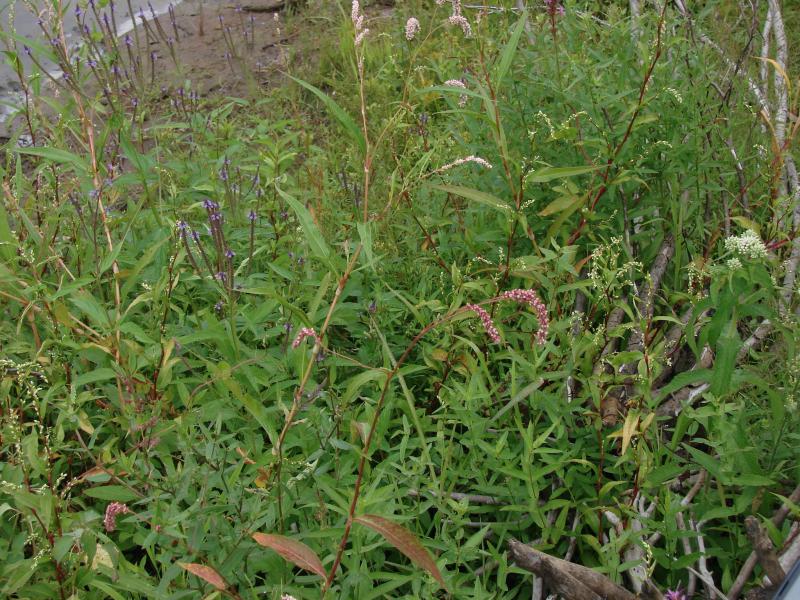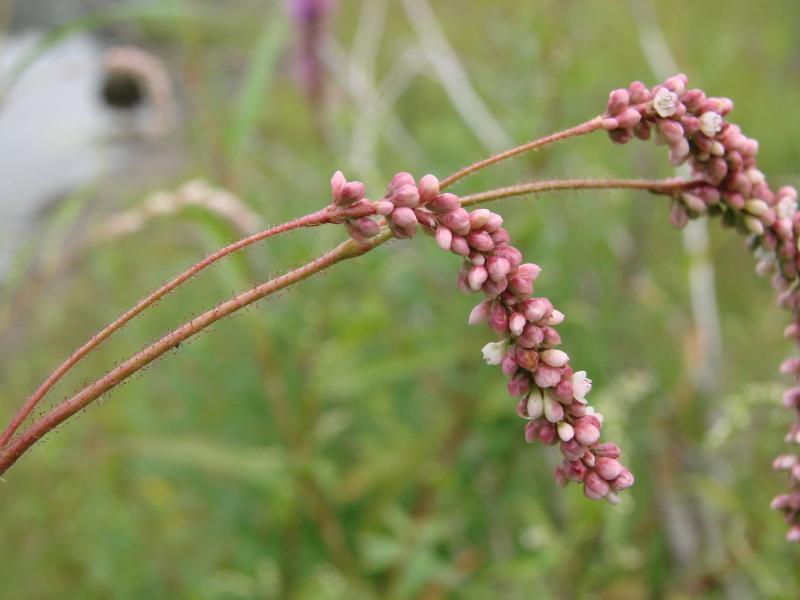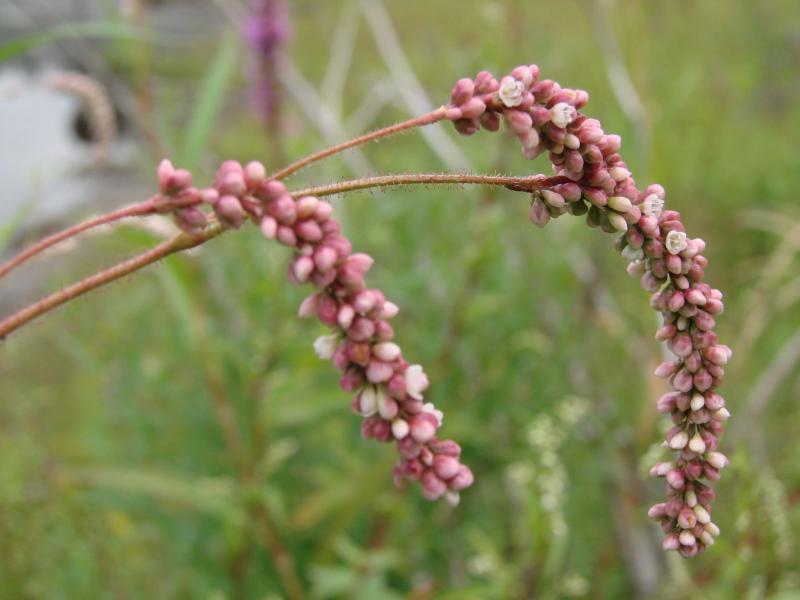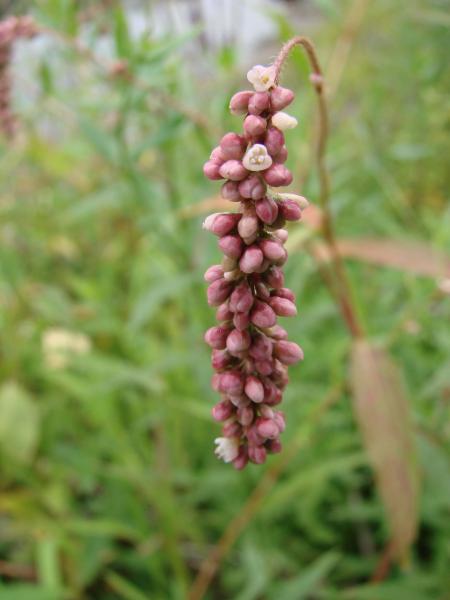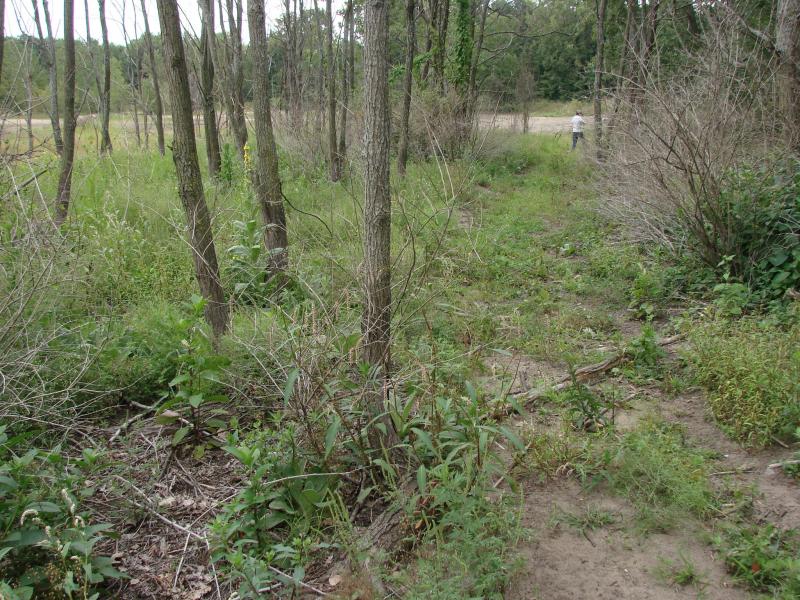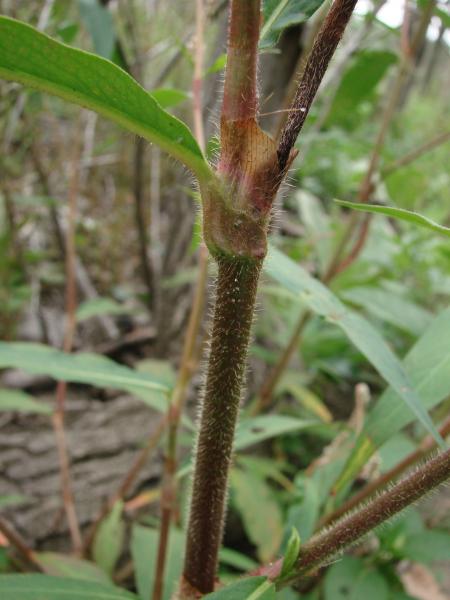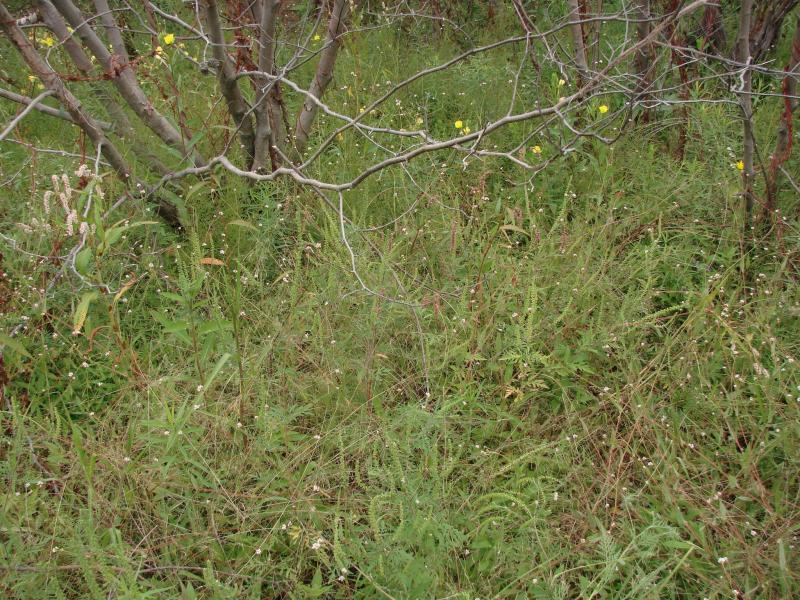Carey's Smartweed
Persicaria careyi (Olney) Greene
- Class
- Dicotyledoneae (Dicots)
- Family
- Polygonaceae (Buckwheat Family)
- State Protection
- Endangered
Listed as Endangered by New York State: in imminent danger of extirpation in New York. For animals, taking, importation, transportation, or possession is prohibited, except under license or permit. For plants, removal or damage without the consent of the landowner is prohibited.
- Federal Protection
- Not Listed
- State Conservation Status Rank
- S1S2
Critically Imperiled or Imperiled in New York - Especially or very vulnerable to disappearing from New York due to rarity or other factors; typically 20 or fewer populations or locations in New York, very few individuals, very restricted range, few remaining acres (or miles of stream), and/or steep declines. More information is needed to assign either S1 or S2.
- Global Conservation Status Rank
- G4
Apparently Secure globally - Uncommon in the world but not rare; usually widespread, but may be rare in some parts of its range; possibly some cause for long-term concern due to declines or other factors.
Summary
Did you know?
This is the only species of smartweed in New York that has big drooping spikes of pink flowers on glandular hairy red stems. Its seeds may lie dormant underwater for many years until water levels lower and the plants germinate. The species was named by Stephen Thayer Olney, a Rhode Island botanist, after John Carey, an English botanist who travelled to the United States in 1830-1852. He worked with Asa Gray in North Carolina in 1841 and returned to England in 1852. He contributed sections on Carex and Salix to Asa Gray's 1848 Manual of the Botany of the Northern United States (John Carey in The Darwin Correspondence Project, www.darwinproject.ac.uk, accessed 16 November 2007).
State Ranking Justification
There are only seven existing populations and all of them are either small or under some threat by human disturbance or invasive species. There are 17 historical records and some of these may be rediscovered when shoreline conditions are right for germination and growth. About five of these records have been destroyed by development in the New York City area.
Short-term Trends
More surveys are needed to determine short-term trends especially since most occurrences have low numbers of plants and occur in habitats where they do not appear every year.
Long-term Trends
Many historical records occured in areas that have been developed and present sites occur in areas that are subject to human disturbance. The species was probably much more common in the past.
Conservation and Management
Threats
Threats include any damage or improper management of pond shores including trampling, ATV use, or mowing of the pond shore vegetation. The crowding out of pond shore vegetation by Phragmites is also a threat.
Conservation Strategies and Management Practices
Prevent human disturbance of shoreline populations during the growing season and prevent the destruction of habitat by Phragmites or other shoreline invasives.
Research Needs
Research is needed to determine how long populations can survive through seed banking and when to consider a population extirpated if habitat still exists. Management techniques for water level changes should be studied to determine the optimum levels for preservation of shoreline populations.
Habitat
Habitat
In New York Carey's Smartweed has been collected from a broad variety of sites, including coastal plain pond shores, roadside and powerline right-of-ways,and talus slopes. All of these sites are at least intermittently wet; some have peaty or mucky soils, some sandy, and some a mixture. More information on the habitat requirements of this species, which may well vary within its range from Canada to Long Island, is needed (New York Natural Heritage Program 2007). Low thickets, swamps, recent burns, clearings and cultivated ground (Fernald 1970). Moist or wet ground, fields, roadsides and meadows (Gleason & Cronquist 1991).
Associated Ecological Communities
- Coastal plain pond shore
(guide)
The gently sloping shore of a coastal plain pond with seasonally and annually fluctuating water levels. Plants growing on the pond shore vary with water levels. In dry years when water levels are low there is often a dense growth of annual sedges, grasses, and herbs. Submerged and floating-leaved aquatic plants, such as fragrant waterlily and pondweeds, may become "stranded" on the exposed shore. In wet years when the water level is high only a few emergents and floating-leaved aquatics may be noticeable. T
- Pine barrens shrub swamp*
(guide)
A shrub-dominated wetland that occurs in shallow depressions in the coastal plain, often as the transition zone between a coastal plain pond shore and either pitch pine-scrub oak barrens or pitch pine-oak forest.
- Pine barrens vernal pond*
(guide)
A seasonally fluctuating pond and its associated wetlands that typically occurs in pine barrens. The water is intermittent, usually a pond in the spring but sometimes losing water through the summer to become a mostly vegetated wetland at the end of the summer. These ponds and wetlands may be small.
* probable association but not confirmed.
Associated Species
- Acer rubrum
- Atriplex dioica (thick-leaved orach)
- Carex lurida (sallow sedge)
- Cephalanthus occidentalis (buttonbush)
- Dichanthelium clandestinum (deer-tongue rosette grass)
- Euthamia caroliniana (slender flat-topped-goldenrod)
- Eutrochium purpureum
- Juncus canadensis (Canada rush)
- Juncus effusus
- Lonicera morrowii (Morrow's honeysuckle)
- Ludwigia alternifolia (alternate-leaved seed-box)
- Persicaria lapathifolia (dock-leaved smartweed)
- Persicaria longiseta (low smartweed)
- Persicaria pensylvanica (Pennsylvania smartweed)
- Saponaria officinalis (bouncing-bet, common soapwort)
- Scirpus cyperinus (common wool-grass)
- Solidago gigantea (swamp goldenrod)
Range
New York State Distribution
This plant has been observed at scattered locations in eastern New York from the northern tip of the state (Clinton County) to Long Island. There is also a single historical record from Onondaga County in Central New York.
Global Distribution
Carey's Smartweed is found from New Brunswick to Ontario, and south to Minnesota, Illinois, Kentucky, and Maryland. It is a species of conservation concern in much of its range.
Identification Comments
General Description
Persicaria careyi is an annual species growing up to 1.5 m tall. The leaves have stipules that unite to form a sheath around the stem (an ocrea), characteristic of the family; in this species the ocrea has a bristly fringe around the summit. The leaves are lance-shaped, 6-18 cm long and only 1-3.5 cm wide, and covered with rough hairs. The flowers are borne in tightly packed, drooping racemes, and are rose-colored to purple, 5-parted and united at the base. The upper stem and the pedicels are covered with glandular hairs.
Best Life Stage for Proper Identification
Persicaria careyi is best identified when flowers or mature fruit are present.
Similar Species
Persicaria careyi is the only species of Persicaria in New York that has a glandular upper stem and drooping, rosy-colored flowers.
Best Time to See
Persicaria careyi flowers from August to early October.
- Flowering
- Fruiting
The time of year you would expect to find Carey's Smartweed flowering and fruiting in New York.
Carey's Smartweed Images
Taxonomy
Carey's Smartweed
Persicaria careyi (Olney) Greene
- Kingdom Plantae
- Phylum Anthophyta
- Class Dicotyledoneae
(Dicots)
- Order Polygonales
- Family Polygonaceae (Buckwheat Family)
- Order Polygonales
- Class Dicotyledoneae
(Dicots)
- Phylum Anthophyta
Additional Common Names
- Pinkweed
- Smartweed
Synonyms
- Polygonum careyi Olney
Additional Resources
Best Identification Reference
Crow, Garrett E. and C. Barre Hellquist. 2000. Aquatic and Wetland Plants of Northeastern North America: A revised and enlarged edition of Norman C. Fassett's a Manual of Aquatic Plants. Volume One: Pteridophytes, Gymnosperms, and Angiosperms: Dicotyledons. The University of Wisconsin Press. Madison, Wisconsin. 536 Pages.
Other References
Clemants, Steven and Carol Gracie. 2006. Wildflowers in the Field and Forest. A Field Guide to the Northeastern United States. Oxford University Press, New York, NY. 445 pp.
Fernald, M.L. 1950. Gray's manual of botany. 8th edition. D. Van Nostrand, New York. 1632 pp.
Flora of North America Editorial Committee. 2005. Flora of North America North of Mexico, Volume 5, Magnoliophyta: Caryophyllidae, Part 2. Oxford University Press, New York.
Gleason, Henry A. and A. Cronquist. 1991. Manual of Vascular Plants of Northeastern United States and Adjacent Canada. The New York Botanical Garden, Bronx, New York. 910 pp.
Haines, Arthur and Thomas F. Vining. 1998. Flora of Maine. A Manual for Identification of Native and Naturalized Vascular Plants of Maine.
Holmgren, Noel. 1998. The Illustrated Companion to Gleason and Cronquist's Manual. Illustrations of the Vascular Plants of Northeastern United States and Adjacent Canada. The New York Botanical Garden, Bronx, New York.
New York Natural Heritage Program. 2010. Biotics database. New York Natural Heritage Program. New York State Department of Environmental Conservation. Albany, NY.
New York Natural Heritage Program. 2024. New York Natural Heritage Program Databases. Albany, NY.
Newcomb, Lawrence. 1977. Newcomb's Wildflower Guide: An Ingenious New Key System for Quick, Positive Field Identification of the Wildflowers, Flowering Shrubs, and Vines of Northeastern and North-Central North America. Little, Brown and Company. Boston.
Rhoads, Ann F. and Timothy A. Block. 2000. The Plants of Pennsylvania, an Illustrated Manual. University of Pennsylvania Press, Philadelphia, PA.
Weldy, T. and D. Werier. 2010. New York flora atlas. [S.M. Landry, K.N. Campbell, and L.D. Mabe (original application development), Florida Center for Community Design and Research http://www.fccdr.usf.edu/. University of South Florida http://www.usf.edu/]. New York Flora Association http://newyork.plantatlas.usf.edu/, Albany, New York
Weldy, Troy W. and David Werier. 2005. New York Flora Atlas. [S.M. Landry, K.N. Campbell, and L.D. Mabe (original application development), Florida Center for Community Design and Research. University of South Florida]. New York Flora Association, Albany, NY. Available on the web at (http://newyork.plantatlas.usf.edu/).
Links
About This Guide
Information for this guide was last updated on: January 14, 2011
Please cite this page as:
New York Natural Heritage Program. 2024.
Online Conservation Guide for
Persicaria careyi.
Available from: https://guides.nynhp.org/careys-smartweed/.
Accessed July 26, 2024.

